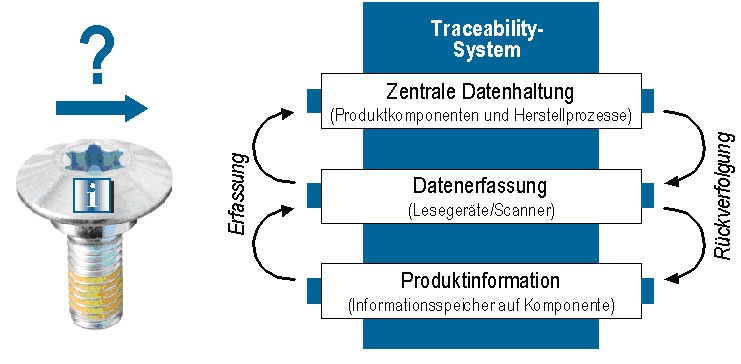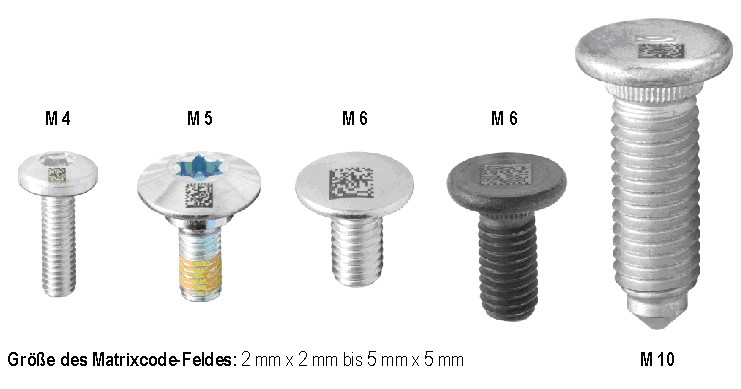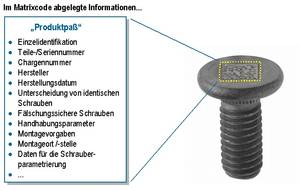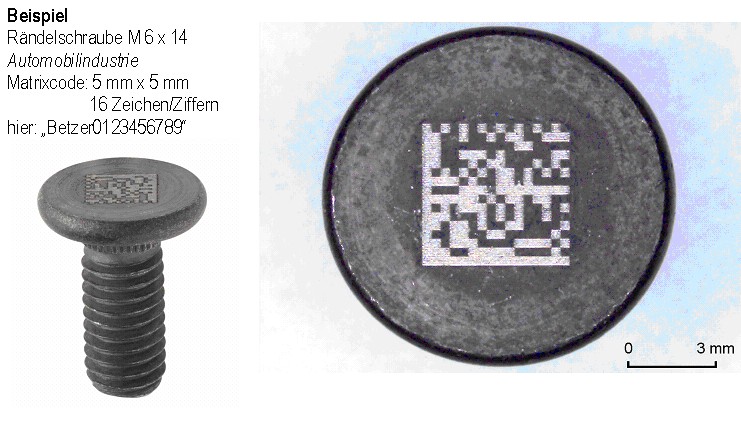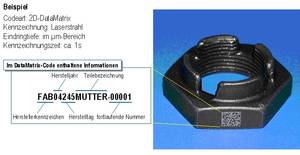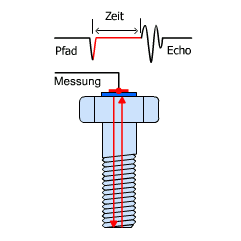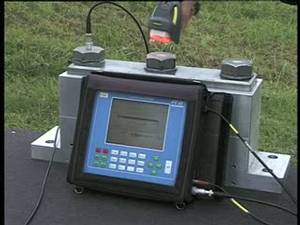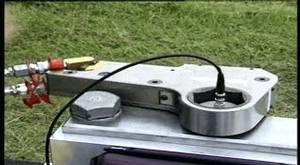digifast® - fastener with machine readable 2D-/ 3D-/ hologramme information storage capacity
Fastening with screws is still a modern way of connecting material due to the ability to document the fastening process and to unscrew and reconnect the fasteners if required. In the last 10 years a first generation of "intelligent fasteners" has emerged, capable of independent threadforming. One of the advantages of these "threadforming screws" is the integration of the threadforming in the mounting process reducing assembly time and costs considerably.
Now we at Betzer have developed a new generation of "intelligent fasteners". This generation is equipped with a machine readable 2D-/ 3D-/ hologramme information storage capacity function called "digifast®". The storage capacity function can access data such as information about the screw itself, its production history and the mounting instructions, etc.
The digifast® information storage function can be used on screws, nuts, studs and washers.
Traceability System
Innovative manufacturers fulfill this duty of production process documentation by means of a traceability system. This contains the identification of the parts and components mounted in any given product and the details of specific production processes carried out. The identification of the parts is carried out via an information storage label containing a clear part identification number. The information storage label can be read by a scanner and matched with the component information and the details of specific production processes stored in a central database. That enables the tracebility of every individual part produced throughout the complete manufacturing process and the supply chain.
Information storage on products
Different kinds of information storage are available e.g. optical-, magnetic- or radio readable. The optical information storage is very well suited to individual components, as it is easy and cost effective to apply to the surface of the product. In the recent past the one-dimensional information storage code, e.g. barcode, was usual. Nowadays however, the two-dimensional information storage, e.g. data-matrix-code, is becoming more and more common. Such a data-matrix-code comprises a high information density in a small area, so it is possible to store redundant information for. This also allows error correction enabling the reading and decoding of dirty or damaged codes.
Information storage on a screw
Should fasteners like screws, nuts, studs and washers be fitted with a machine readable matrix code, they will be able to supply all information about their production history and assembly requirements. This provides a "product passport" for every individual part. In addition to the identification of the fastener the part-, serial- , and batch number of the manufacturer and the production date can also be retrieved.
Additionally the data matrix code can make mounting tools more intelligent. The data matrix code provides the information on handling and mounting parameters and the mounting position. When comparing the information on the fastener with the information stored on the mounting robot a wrong fastener or assembly can be detected and prevented immediately.
Copy protected fasteners
Using a data matrix code on the fastener enables fasteners to be copy protected. For that reason every single fastener receives its individual encrypted identification number and the manufacturer provides the customer with a list of the encrypted information used and the decrypting mechanism. This gives the customer the opportunity to check if the part used is original. Should fasteners with an identical code appear which cannot be decoded, it can be assumed that this screw is a fake.
Fields where fasteners with information storage are used
Fasteners with information storage are particularly used in branches of industry where safety is imperative eg. automotive, aviation, wind turbine parks, military, chemical, power stations, construction.
Clamp load controlled tightening of bolts in wind energy plants:
An application for the Digifast® Technology
An example of a successful application of the Digifast® technology is found in the wind energy industry: For the storage of the identification number and ultrasonic technical information Intellifast GmbH vequips bolts with an ultrasonic transducer and a 2D-barcode. This combination allows for simple and quick determination of the current bolt load during assembly in a wind energy plant.
The Intellifast advantage is in the transducer: thin, rugged and permanently applied to your bolt. Using the industry proven ultrasonic pulse-echo technique to determine fastener tension load with the additional advantage over conventional technologies that the there is no separate transducer or couplant. The Intellifast technology is truly operator independent.
The Permanent Mounted Transducer System. The system for accurate bolted joint connections
The Permanent Mounted Transducer System connects the bolting technology seamless with the ultrasonic measurement technology. Intellifast GmbH equips standard bolts with a permanent mounted ultrasonic transducer. With the help of a measuring pin, which is integrated in the tightening tool, the accurate clamp load of the fastening elements can be measured during assembly. This gives you current information of the condition of bolted joint connections.Intelligent measurement devices complete the PMT System. It makes an easy and non-destructive clamp load measuring in tightened condition possible and is an essential inspection tool.
Video documentation "Bolt identification" and "Load controlled tightening"
uring the Husum WindEnergy Intellifast GmbH introduced the easy manageable technique for bolt identification, clamp load controlled bolt assembly, and clamp load documentation using coded transducers.
On the right side you can select two movies:
The first ("Bolt Identification") movie shows how fast the barcode reader identifies the bolt and reads all information necessary to measure the bolt in the field without having a reference file (e.g. a file generated during the assembly) at hand:
The ID code stored on the bolt contains the BIR file number which allows the measurement device "LP3000B" automatically selecting the correct ultrasonic settings required to measure the bolt as well as finding and indicating the target load of the application. Additionally there is information derived from the code allowing the system to calculate the individual BTOF (Base-Time-Of-Flight, ultrasonic run-time at zero load) of the bolt and use it for the calculation of the actual given bolt load. With the next prompt a complete documentation of the load situation of the bolt (including date, time, temperature, comment, etc.) is stored. The second ("Load controlled tightening") movie shows how a wind turbine tower bolt is tightened to target load by pressing a single button:
When target load is reached, the LP3000B sends a stop signal to the hydraulic pump of the tightening tool. Again, the following prompt on the LP3000B documents the load.
Link: www.intellifast.de
The advantages and costs of coding fasteners
See downloads below...

